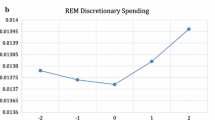Abstract
A number of recent studies have shown that earnings information is less useful and value relevant when firms are financially troubled. This finding has given rise to the consideration of alternatives. In this paper, we examine the contributions of book value-based proxies (normal earnings and abandonment value) and flow-based proxies (earnings and operating accruals) to the assessment of the likelihood of emergence from financial distress. Our prior reasoning is that while book value-based proxies may provide information about potential future cash resources, flow-based proxies, because they capture the progress of reorganization efforts underway, as opposed to mere potential, should be relatively more useful in assessing the likelihood of emergence from distress. Our findings are consistent with this explanation. We document that the primary predictors of emergence are flow-based proxies—in particular, cash from operations, net of earnings.
Similar content being viewed by others
References
Altman, E. I., “Financial Ratios, Discriminant Analysis and the Prediction of Corporate Bankruptcy.” Journal of Finance (September), 589–610 (1968).
Barth, M., W. Beaver, J. Hand and W. Landsman, “Accruals, Cash Flows, and Equity Values.” Review of Accounting Studies 3, 205–229 (1999).
Barth, M., W. Beaver and W. Landsman, “Relative Valuation Roles of Equity Book Value and Net Income as a Function of Financial Health.” Journal of Accounting and Economics 25, 1–4 (1998).
Barth, M. D. Cram and K. Nelson, “Accruals and the Prediction of Future Cash Flows.” The Accounting Review 76(January), 27–58 (2001).
Basu, S., “The Conservative Principle and the Asymmetric Timeliness of Earnings.” Journal of Accounting and Economics 24, 3–37 (1997).
Berger, P., E. Ofek and I. Swary, “Investor Valuation of the Abandonment Option.” Journal of Financial Economics 42, 257–287 (1996).
Bryan, D., S. Tiras and C. Wheatley, “The Interaction of Solvency With Liquidity and Its Association With Bankruptcy Emergence.” Journal of Business Finance and Accounting 29, 935–965 (2002).
Casey, C., V. McGee and C. Stickney, “Discriminating Between Reorganized and Liquidated Firms in Bankruptcy.” The Accounting Review 61, 249–62 (1986).
Campbell, S., “Predicting Bankruptcy Reorganization for Closely Held Firms.” Accounting Horizons 10, 12–25 (1996).
Collins, D., M. Pincus and H. Xie, “Equity Valuation and Negative Earnings: the Role of Book Value of Equity.” The Accounting Review 74(January), 29–61 (1999).
Denis, D. J. and D. K. Denis, “Causes of Financial Distress Following Leveraged Recapitalizations.” Journal of Financial Economics, 129(February) 157 (1995).
Dunn, K. A., C. E. L. Tan and E. K. Venuti, “Audit Firm Characteristics and Type II Errors in the Going-concern Opinion.” Asia Pacific Journal of Accounting and Economics (2002).
Holder-Webb, L. M. and M. S. Wilkins, “The Incremental Information Content of SAS No. 59 Going-Concern Opinions.” Journal of Accounting Research (Spring), 209–219 (2000).
Hopwood, W., J. McKeown and J. Mutchler, “A Reexamination of Auditor Versus Model Accuracy Within the Context of the Going Concern Opinion Decision.” Contemporary Accounting Research 11 (Spring): 409–431 (1994).
Jones, F. “Current Techniques in Bankruptcy Prediction.” Journal of Accounting Literature 6 131–64 (1987).
Kane, G. D., F. M. Richardson and N. L. Meade, “Rank transformations and the prediction of corporate failure.” Contemporary Accounting Research 15, 145–167 (1998).
Lang, L.H. P. and R. M. Stulz, “Contagion and Competitive Intra-industry Effects of Bankruptcy Announcements.” Journal of Financial Economics (August): 45–60 (1992).
Ohlson, J., “Earnings, Book Values and Dividends in Security Valuations.” Contemporary Accounting Research 11 (Spring): 661–687 (1995).
Palepu, K., “Predicting Takeover Targets: a Methodological and Empirical Analysis.” Journal of Accounting and Economics 8 (March): 3–35 (1986).
Tan, C. E. L., “The Asymmetric Information Content of Going-Concern Opinions-Evidence from Bankrupt Firms With and Without Prior Distress Indicators.” Working Paper, Baruch College—CUNY (2002).
White, M., Bankruptcy Liquidation and Reorganization: Handbook of Modern Finance (Warren, Gorham and Lamont, Boston, MA, 1984).
Zavgren, C. “The Prediction of Corporate Failure: The State of the Art.” Journal of Accounting Literature 2: 1–37 (1983).
Author information
Authors and Affiliations
Corresponding author
Rights and permissions
About this article
Cite this article
Kane, G.D., Richardson, F.M. & Velury, U. The Relevance of Stock and Flow-Based Reporting Information In Assessing the Likelihood of Emergence from Corporate Financial Distress. Rev Quant Finan Acc 26, 5–22 (2006). https://doi.org/10.1007/s11156-006-7030-5
Issue Date:
DOI: https://doi.org/10.1007/s11156-006-7030-5



